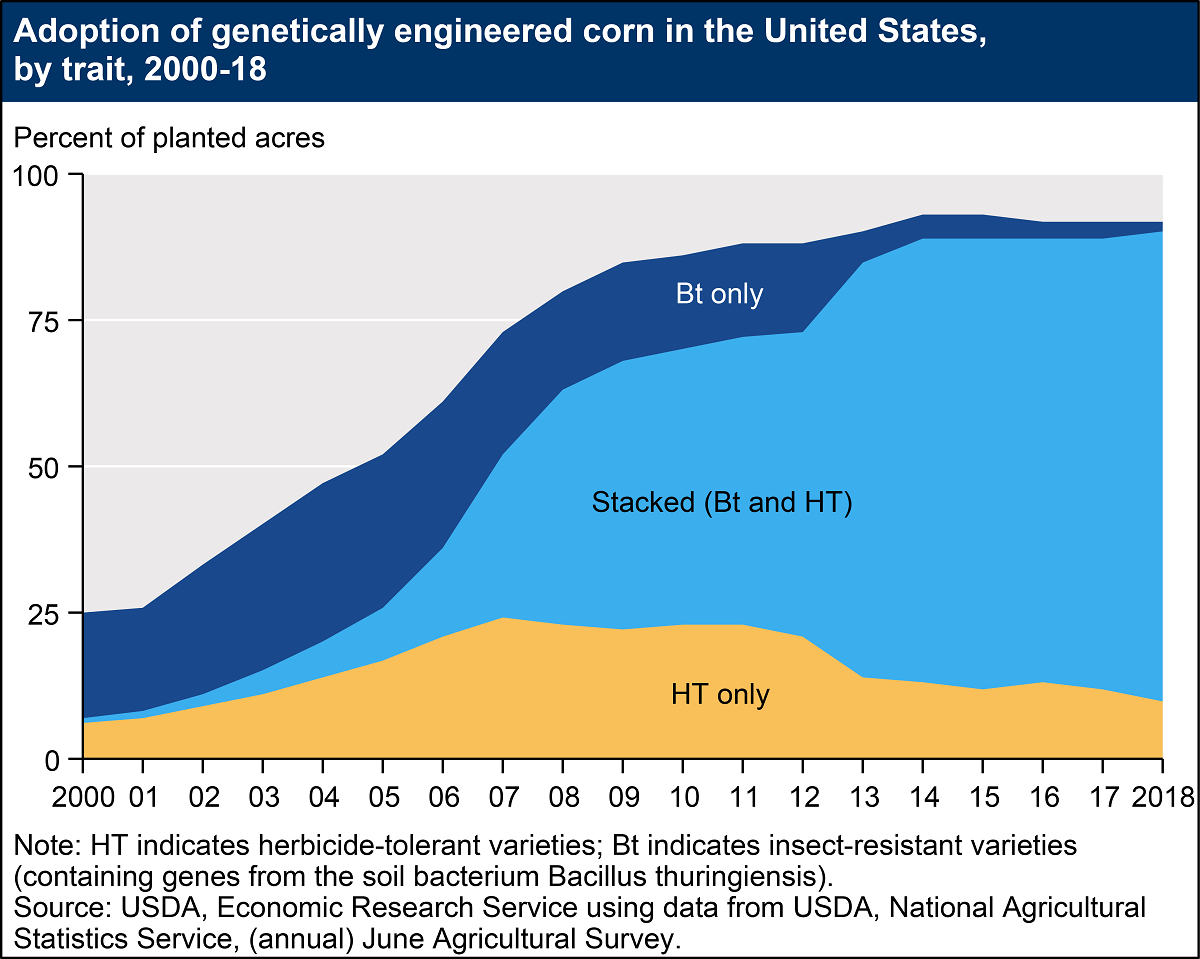
Adoption of GE Corn, Cotton, and Soybeans in the U.S. Close to Saturation, USDA-ERS Reports
September 25, 2019| |
Adoption of GE crops with stacked traits accelerated in recent years, providing farmers with better seeds with multiple traits optimal for production. In 2018, approximately 82% of cotton and 80% of corn planted in the US were stacks. This is according to the Adoption of Genetically Engineered Crops in the US published by the US Department of Agriculture's Economic Research Service (USDA-ERS).
Herbicide tolerant crops, which provide farmers with more options to control weeds, have been adopted in the US starting 1996. HT soybeans rose from 17% in 1997 to 68% in 2001, before plateauing at 94% in 2014. HT cotton rose from 10% in 1997 to 56% in 2001, before reaching a high of 91% in 2014. HT corn adoption rates increased following the turn of the century and reached 90% in 2018.
Adoption of insect resistant Bt corn went up from 8% in 1997 to 82% in 2018. Bt cotton adoption also increased from 15% in 1997 to 85% in 2018. Adoption rates for Bt crops may fluctuate over time, depending on the severity of pest infestations.
Stacked seeds containing both HT and Bt traits continuous to accelerate, taking up a higher percentage of planted acres than GE crops with single traits. Global use of GE seeds are available in the ISAAA report, Global Status of Commercialized Biotech/GM Crops: 2018.
Read more about the recent trends in GE Adoption in the US from the USDA-ERS website.
| |
You might also like:
- Global Status of Commecialized Biotech/GM Crops: 2018
- US, Highest Producer of Biotech Crops in 2018, Gov't Support Vital
- Stacked Traits in Biotech Crops
Biotech Updates is a weekly newsletter of ISAAA, a not-for-profit organization. It is distributed for free to over 22,000 subscribers worldwide to inform them about the key developments in biosciences, especially in biotechnology. Your support will help us in our mission to feed the world with knowledge. You can help by donating as little as $10.
-
See more articles:
-
News from Around the World
- Nigeria Stresses Importance of Biotechnology for Food Security
- Study Opens Door to Flood Resistant Crops
- Scientists Discover Way to Make Crops Grow in Salty Soils
- Adoption of GE Corn, Cotton, and Soybeans in the U.S. Close to Saturation, USDA-ERS Reports
- Biologists Identify Six Genes in Maize Responsible for Production of Plant Antibiotics
- Safety Assessment of GM Crops Completed in Korea
- Bt Brinjal Technology Boosts Yield, Reduces Pesticides in Bangladesh, IFPRI Reports
- Most Complete Potato Genome Sequence Published
-
Research Highlights
- Analysis of Expression Profiles of Nuclear Factor-Y Genes in Cassava
- Hydrophobic Forces, Not H-Bonds, Bind DNA Together
-
Plant
- Engineering Broad-Spectrum Bacterial Blight Resistance in Rice Using CRISPR-Cas9
- Scientists Use CRISPR to Develop Apples Resistant to Fire Blight
-
Read the latest: - Biotech Updates (November 12, 2025)
- Gene Editing Supplement (October 29, 2025)
- Gene Drive Supplement (February 22, 2023)
-
Subscribe to BU: - Share
- Tweet

